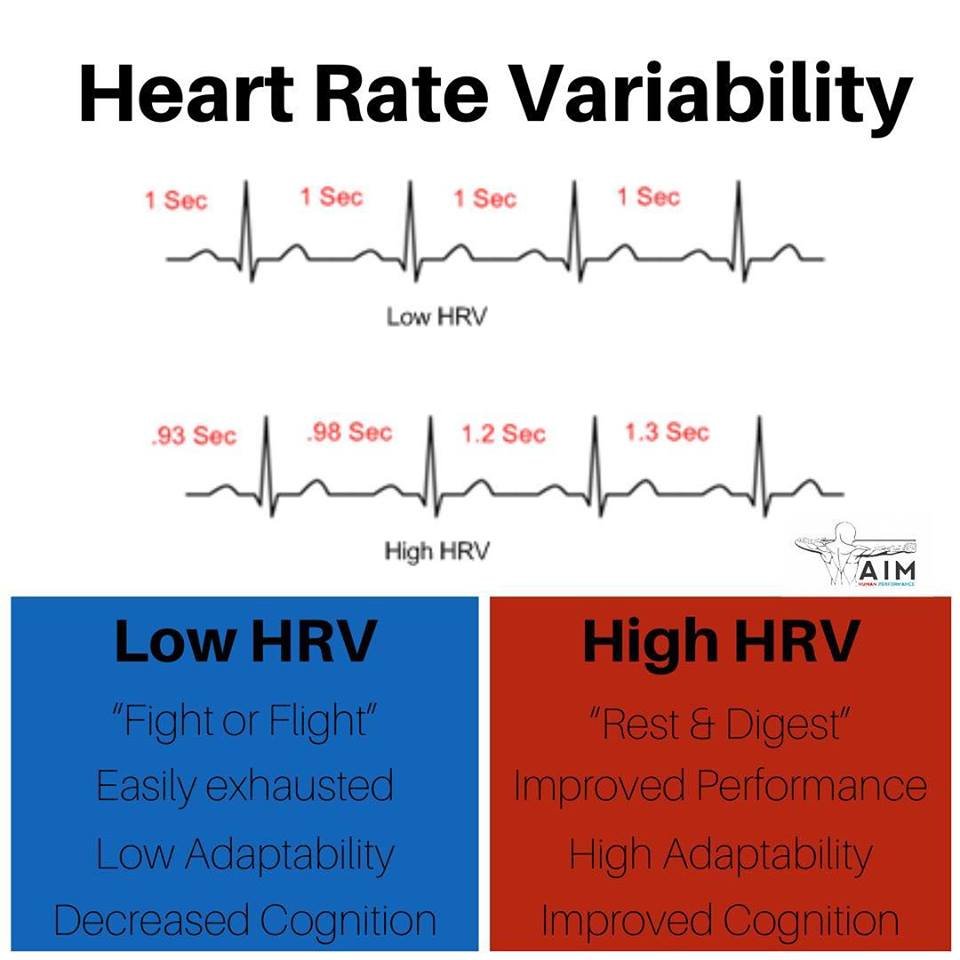What is HRV and why should you care?
Everyone is buzzing about HRV.
What is it, and should we care about it?
1. What is HRV?
Heart Rate Variability (HRV) is the measure of the variation in time between heartbeats. It’s a component of the autonomic nervous system which is responsible for recovery and the body’s response to stress. Unlike basic heart rate that counts the number of beats per minute, HRV looks at the changes in between successive beats, and the balance between sympathetic (fight-or-flight intensity) and parasympathetic (rest-and-digest relaxation) tone. The autonomic nervous system balances these 2 forces so you can respond appropriately to daily stressors, and helps regulate heart rate, respiration and digestion.
2. A high HRV is better than a low HRV
Some situations result in an increase in variation (high HRV), while others cause the intervals between beats to stay more constant (low HRV).
Low HRV: If the intervals between your heartbeats are relatively constant, then you are in a fight-or-flight state.
High HRV: If the interval between heartbeats varies, you are in a more relaxed state.
3. What is a GOOD HRV value?
A higher HRV correlates with better health, resilience, and increased fitness. It means that your body is reacting to stimuli and constantly adapting.
A lower HRV indicates your nervous system is fatigued and not responding as quickly to the stresses of training.
Age plays a role in what constitutes a ‘good’ HRV score with decreases occurring as we get older.
HOWEVER, rather than comparing yourself to these reference ranges, or to your friends and family, it’s more important to follow your own HRV trends. Pay attention to the delta between days rather than the raw number. Once you establish a baseline HRV, you can monitor positive and negative trends in fitness, fatigue, and readiness to perform at your best.
4. How can you CHANGE your HRV?
HRV fluctuations are normal and, in some cases, desirable. For example, during strenuous exercise, low HRV is a reflection of your fight-or-flight system appropriately dominating to get your HR up. Your HRV will rebound afterwards, as your rest-and-digest system takes over to help you recover.
HRV can drop substantially when you get sick and can stay low even after you feel better indicating that your body is still recovering.
Differences in hormone levels, diet, outside stressors and sleep quality also affect HRV.
HRV data can be used to determine when you’re less likely to perform at your best or even suggest a higher risk for injury.
An acute stress response can become chronic in modern day life with stresses related to work, relationships, finances, lifestyle, etc. Chronically accumulated stress from multiple sources can contribute to drastically reduced health and performance long term.
5. HOW should you measure your HRV?
Wearable sensors like Whoop and Oura work by shining light through your skin, and measuring how much is reflected back by the blood traveling through your veins to determine how fast your heart is beating. This is how finger clip pulse oximeters work.
Because every optical HR sensor is slightly different and can be affected by your skin tone, placement, and how tight the device is worn, there are several variables at play when it comes to the accuracy of these sensors.
It has been well established that they do not match the point-to-point accuracy of a chest strap to monitor interbeat variation required for HRV measures.
One alternative to a wearable is to measure your HRV with an app called EliteHRV. You simply use your compatible heart rate monitor chest strap and connect it to the app for 2 minutes each morning upon waking. As mentioned above, the chest strap can measure the interbeat variation most accurately.
6. WHEN should you measure your HRV?
Heart rate and heart rate variability are often considered similar metrics, but they have completely different uses when used correctly.
Heart rate is best used during exercise. It is a great tool for training the cardiovascular system or monitoring the effects of training on the cardiovascular system in real time.
HRV is best used during a rested state (usually first thing in the morning or during rested activities such as meditation). Take daily morning readings and be consistent so you can evaluate trends over time. Measure HRV every day, at the same time, in the same position (supine is best) to rule out confounding variables.
HRV can be used as a daily check-in with the body to determine its readiness to tolerate stress on a given day. In this regard, HRV is commonly used to optimize and individualize training programs based on a person’s’ readiness or recovery state.
HRV can also be used to determine how various lifestyle choices (alcohol in the evenings, food choices, sleep habits, etc) affect health and performance by trending HRV and correlating those events over time.





